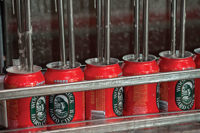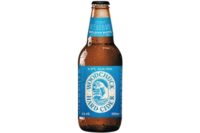If you were to ask Bret Williams a year ago whether he would ever sell Vermont Hard Cider Co., the answer would have been, “No.” When the president and chief
|
Jump to: Growth spurt Passionate fan base Environmental focus From tiny to small |
executive officer of the Middlebury, Vt.-based company originally purchased the Woodchuck hard cider brand and facility in 2003, it was not about developing a big company or brand; it was about saving jobs.
Joining the company in 1996 as its first sales associate, Williams had seen the company go through some ownership transitions over the years, and when it fell upon hard times financially, he stepped in to put a deal together to buy the business.
“I did everything people tell you not to do,” he says. “I pulled out my 401k, I mortgaged my house, took all the change out of the ashtray in my car. I took all the money I had and put it into this thing, and you know it wasn’t about growing a big company or a big brand; it was about saving jobs. These are the people I worked with, and I knew that if I didn’t get the deal done, it would either go to a larger supplier that would shut the place down or would have to close it altogether, and that was not an option. I wanted to save the brand and save jobs.”
Under Williams’ leadership, the company came back from the verge of bankruptcy. It built up its sales force between 2005 and 2007 and started to innovate its hard cider recipes, which was a huge turning point for the brand, Williams explains. Growing from an employee base of 42 people in 2003 to its current 155-person staff, Vermont Hard Cider Co. shipped just shy of 4 million cases in 2012 to all 50 states, Williams says. Its Woodchuck brand family also continues to lead the U.S. hard cider market with sales of nearly $38.6 million for the 52-week period ending Dec. 30, 2012, in total U.S. multi-outlets including supermarkets, drug stores, mass merchandisers, gas and convenience stores, military commissaries, and select club and dollar retail chains, according to Chicago-based SymphonyIRI Group.
But when the company announced in October that it had been acquired by Dublin-based C&C Group for $305 million, Williams jokes that even he was surprised by the announcement.
“I never thought we would sell, and [we] never put a for-sale sign in the yard,” he says. “It was an unsolicited offer and it clearly got my attention, and the more I got to know the guys at C&C, it’s like-minded companies.”
C&C Group has been making cider since 1935 and is almost exclusively a pure hard cider company, Williams explains.
“They’re interested in keeping brands authentic and they care about the environment; [there’s] just a lot of similarities between the two businesses,” he says. “They committed to keeping all the employees and they were also committed to build this new $30 million cidery that’s going to go in the ground [in April], so if you look at all those things together, it made the decision easier.”
The new facility, which breaks ground this spring, will be approximately 100,000 square feet and also will be in Middlebury. The company also will continue to operate some production out of its current 62,000-square-foot cidery, but the new facility will serve as its main production site and also will include corporate offices and a visitor’s center, Williams says.
Growth spurt
Vermont Hard Cider Co. has come a long way since the 1991 recipe release of its Woodchuck Amber variety. Now the company maintains between 20 and 25 SKUs across four sub-segments: core ciders, limited release, Private Reserves and Farmhouse Select, Williams explains.
The core ciders are available every day and feature the Amber variety — the company’s top seller — as well as five additional varieties: Granny Smith, which is made from only Granny Smith apples; 802 Dark & Dry, which contains caramelized sugar; Crisp, a session cider; Pear; and Raspberry. The company also packages Amber, Granny Smith, 802 and a rotating cider style in a 12-pack variety package, which is the company’s fastest-growing package, Williams says.
Available on a more limited basis, Vermont Hard Cider Co.’s limited releases include four seasonal varieties: Winter, Spring, Summer and Fall.
“Those are highlighted by ingredients,” Williams explains. “For example, the Summer that’s about to come out has Maine blueberries in it, and the Spring has Vermont maple syrup in it; the Fall has cinnamon and nutmeg, and the Winter is aged in oak — French and American oak. The French gives a little hint of vanilla, and the American gives it an oaky taste. Those are neat because they’re only available [for] a limited time to match up with the seasons, [and] obviously being in New England, that’s a big part of the lay of the land.”
Also available for a limited time are its small-batch Private Reserve varieties. “Our cider-makers have a recipe sort of library that they play around with, and with the Private Reserves, we’ve been able to put some cider liquid into those bottles that’s never been done anywhere in the world before,” Williams says.
Its latest Private Reserve release is Woodchuck Pink, which was released this February. In conjunction with its release, Vermont Hard Cider Co. donated $50,000 to Dragonheart Vermont’s Survivorship Now, an organization dedicated to helping people with their quality of life after they’ve gone through cancer treatment.
“We’re the size and scope that we can actually make a difference,” Williams says. “It’s really terrific.”
The company’s first Private Reserve release was a Pumpkin variety, which originally included pumpkins from an employee’s pumpkin patch in the recipe, he adds. Other Private Reserve releases include Barrel Select, which combines the sweet and crisp taste of apple cider with smoky and dry flavors of Kentucky bourbon, and Belgian White, which is crafted with Belgian beer yeast and contains coriander and orange notes, the company says.
As a throwback to where the company started in 1991, Vermont Hard Cider Co. offers Farmhouse Select 91, which is made in small batches, contains Belgian beer yeast, has a slightly higher alcohol content than other hard ciders in the portfolio, and is made exclusively of Vermont-grown juice, Williams explains.
“It’s kind of a throwback to where we started 22 years ago in that small garage,” he adds. “We had a small bottling line, and the Farmhouse Select has its own little bottling line. It’s slow and it takes a lot to fill each bottle, but it’s all local Vermont juice grown within 10 to 15 miles of the cidery.”
Although the company originally sourced only Vermont apples, due to its size the Woodchuck brand now sources its apples throughout the United States.
“In the beginning, we could get them all through Vermont,” Williams says. “Now, we’ve way outgrown the state of Vermont. You can’t do it, so we only do business with U.S. companies. Granny Smith, which is one of the top sellers for Woodchuck, that apple is very hard to grow in the Northeast, so we have to get that from Washington state, but we have a relationship with several Vermont growers, upstate New York [growers], really scattered around.”
Passionate fan base
Although the hard cider category makes up less than 1 percent of the overall U.S. beer market, Williams says the Woodchuck brand has benefited from its passionate consumer fan base, which it developed through its grassroots marketing strategies.
“The Woodchuck Amber is the flagship that was invented in 1991, and we have marketed it since the day I started and even before that [to] just try and get more people to taste it because the liquid is amazing,” he says.
Williams adds that it’s not an aggressive sell in bars but instead where consumers are in their comfort zones like at a renaissance festival, outdoor music event, concert venue, etc.
“They’re in their element, enjoying themselves, their guard is down, they’re trying it where they’re having a great time, and it’s an experience,” he says. “We found that that’s a really powerful tool to build a brand.”
And once consumers become fans, they have different ways of showing their passion for the Woodchuck brand. “These fans are incredibly passionate about the brand,” Williams says. “It’s amazing how many Christmas cards we get that say, ‘Dear Woodchuck, Merry Christmas, I love you and I can’t wait to see you in the new year,’ like it’s a person.”
Williams also recalls a time when the company first released its Pumpkin cider and a man from Ohio drove 13 hours each way to get the last two cases off of the warehouse floor. That passion and dedication also has had an influence on some major decisions at Vermont Hard Cider Co. For example, due to the number of consumers who show up unsolicited to the company headquarters, the new facility will include a visitor’s center.
“We have people who show up, [and] they’ll ring our doorbell from Georgia, all over the country, Alaska, you name it,” Williams says. “They say, ‘Hey, we’re here, we know you guys don’t have tours, we just wanted to say hi,’ and we bring them in and take them through.”
But the upcoming addition of a visitor’s center isn’t the only way Vermont Hard Cider Co. has taken consumer requests to heart. Last year, the company released Woodchuck Amber in 12-ounce cans, which was a request from consumers.
“Our consumers love to be outside,” Williams says. “They’re into hiking, biking, fishing, you name it, the beach, boating. They’re active people, and the can is a lot easier to take to the beach or throw a couple in your backpack.”
Less than a year in the market, the 12-ounce Amber can package is the No. 2 fastest-growing package in the company’s portfolio, trailing only the Woodchuck variety pack.
Vermont Hard Cider Co. also uses social media outlets to communicate with its consumers. For the last few years, the company has run a marketing campaign on Facebook in partnership with American Forests where it will plant a tree in the ground if you like the brand on Facebook. Last year, the brand planted 12,672 trees.
“Those are things that we’re helping the environment and staying true to the brand, and it excites our fan base because it’s cool, it’s different,” Williams says.
Environmental focus
Sustainable and environmental practices are not just part of Vermont Hard Cider Co.’s marketing program with American Forests; they’re a part of the company’s day-to-day practices.
“It’s funny, there’s a fine line between a marketing strategy and really just the brand,” Williams says. “The brand’s so genuine and authentic that we do what’s best for the product and the brand itself, and the rest of it almost overlaps into a marketing strategy, even though it’s not a strategy; it’s not intentional.”
For example, the company has been using 100-percent-recycled cardboard for its six-pack secondary packaging for years, Williams says. Although the company doesn’t highlight this on its website or tout it in its marketing, it is moreso weaved into what the brand, the employees and what the state of Vermont is all about, he adds.
“I hate to even say that’s a marketing strategy because it’s not; it’s all about doing what’s right, but that resonates with people because it’s real,” Williams explains. “Because we don’t grandstand that as a strategy, because that’s not our style, we always say, ‘Good people doing good things in a good way.’ That’s kind of how we look at Vermont and our business, and just being true to the brand is kind of the easiest way. Being true to the brand, it resonates with people all over the place.”
A change to the Woodchuck brand’s primary packaging also has had an environmental impact. In 2011, the company transitioned from a green glass bottle to a brown glass bottle. Because the former bottle was produced across North America and the current bottle is mostly made in upstate New York, the company has been able to reduce the number of its trucks on the road, Williams says.
But packaging is just the jumping off point in Vermont Hard Cider Co.’s sustainable practices. The company also purchases 25 percent of its power through CVPS Cow Power, a manure-to-energy program that supports local Vermont farmers. Methane from cow manure is con-verted to power that is sold to the electric company, Williams explains.
“We pay a premium for that and we could easily say, ‘You know, I don’t buy into that’ [and] just go ahead and buy power off the grid like everyone else in the state, but we chose to get 25 percent of our power from that and we pay a premium to do it,” he says.
The company also recently signed on to get an additional 10 to 15 percent of its power from a new solar farm, which will increase its range to roughly 40 percent of total energy power from renewable energy sources, Williams explains. The solar panels are being built now and should be installed and running within the next couple of months, he adds.
Reusing and recycling also are a major part of Vermont Hard Cider Co.’s business practices. “Our goal, we’re close but we’re not quite there yet, [is] we want to be a zero-landfill business,” Williams says. “For the boxes the caps get shipped in, we will ship T-shirts out in those; the strapping that comes around the kegs, we reuse the strapping to ship the kegs back out; all of the shrinkwrap is recycled. If you were zero-landfill, you’d have to compost people’s lunches, and we haven’t gotten there yet. There’s other things we still need to do, but we’re close.”
From tiny to small
Although the hard cider category continues to post strong growth numbers — dollar sales were up more than 84 percent for the 52-week period ending Dec. 30, 2012, in SymphonyIRI-measured channels — the category still has a lot of work ahead of itself to gain ground in the U.S. beer market.
“[The hard cider category is] exploding; it’s really doing well,” Williams says. “Now we need to contain our excitement because it’s still very small; it’s a tiny base.
“[The hard cider category is] exploding; it’s really doing well,” Williams says. |
It’s three-tenths of 1 percent of the beer category, so while it’s growing quickly, we need to temper that enthusiasm. We used to say we were invisible; now we’re tiny, and we’re hoping to get small.”
Williams says the goal is to get the category to 1 percent. “That’s triple the size it is right now, and I think that’s going to happen, no doubt,” he says. “It’s a matter of when, not if.”
As the category looks to expand its U.S. market share, the Woodchuck brand will continue to position its premium, authentic products to consumers who are willing to try innovative new varieties.
“We’re putting things in bottles that were never done locally, and that’s exciting,” Williams says. “From Pumpkin to aging bourbon barrels to Woodchuck Pink, these are things that have never been done before, and that’s the exciting part of where the brand’s been positioned in the market.”








